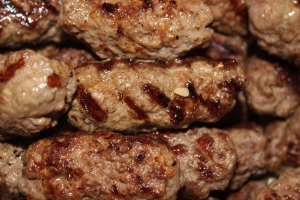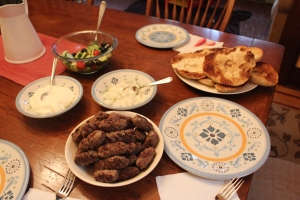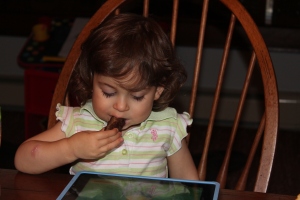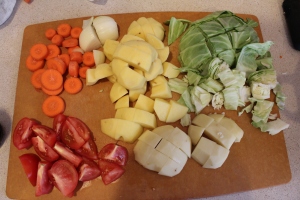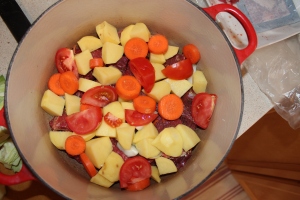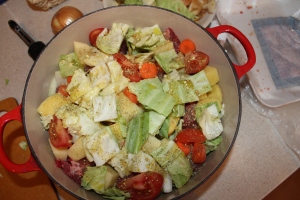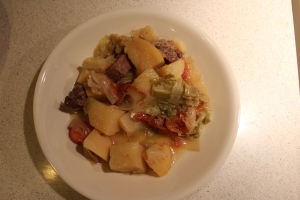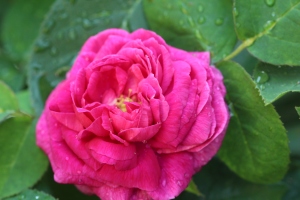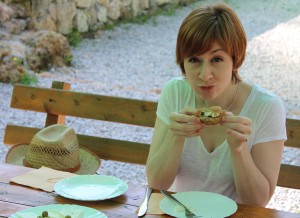Considered by many to be Bosnia’s national dish, cevapi is to Bosnia what the hamburger is to America. Jas requests cevapi every birthday and it is the one food he talks about for weeks before we head to Bosnia. Every Bosnian has their own recipe and you’ll find it in every Bosnian restaurant (some spots only serve cevapi). My father-in-law made it the best but I think I come in a close second. Thankfully it’s easy to prepare in an American kitchen.
Cevapi are little rolled beef sausages classically served with bread, diced onion, and kajmak (a Bosnian cheese). A simple tomato and cucumber salad on the side completes the dinner. While cevapi are eaten year-round (we also make them for New Year’s Eve), they are great on the grill. If you’re looking to change up your traditional barbeque menu this summer, cevapi are the way to go. They can be prepared ahead of time, are easy and affordable to make for a crowd and you can even get your little one to help you roll them. Served family style, eaten with your hands—what could be better?
A few notes about adapting this dish to your kitchen:
Cevapi are served on a type of bread called lepinja which is firm and doughy at the same time. I haven’t found it in America and you could make it, but who wants to knead dough in the summer heat? Sort of defeats the purpose of summer cooking. A bread that comes closest to lepinja and that is much easier to find is ciabatta though a doughy pita bread or even naan could be used with success.
Vegeta is a seasoning blend used widely in Slavic countries. It is easy to find online and some supermarkets are beginning to carry it, but if yours doesn’t or you don’t want to hunt online you could replace it with your favorite blend such as Lawry’s or McCormick’s. I do recommend going the extra step to secure some Vegeta as its uses are endless (Jas sprinkled it on our turkey this past Thanksgiving and it was fabulous).
Kajmak (kai-muk) is a spreadable sheep’s milk cheese. It’s like a cross between butter and cream cheese and the textures vary depending on where you buy it in Bosnia. It is not easy to find in America. There are a number of recipes online detailing how to make your own but I haven’t mastered the process and again, it defeats the purpose of summer cooking. Using a blend of easily found cheeses and some butter, you can whip up your own kajmak to serve with your cevapi. The recipe is below.
Cevapi
Serves 4 -6
- 3 lbs. ground beef (aim for 8o/20 meat/ fat ratio)
- 2 Tbs. vegeta
- 3 cloves garlic minced
- 1/4 – 1/2 cup sparkling water
- 1 cup hot beef broth or water
- Salt & pepper (to taste–I use 1 tsp. salt & 1/2 tsp. pepper)
- Bread (ciabatta pref)
Soak the minced garlic in a little cool water for 15 minutes and drain. Place all ingredients into a large bowl and mix thoroughly with your hands (if the mixture feels too dry–you’ll know if it’s difficult to mix with your hands– add a bit more sparkling water).
Begin forming the cevapi–roll meat into a two inch ball and then roll between your palms into a log shape about two inches long. Place on a cookie sheet and keep rolling until all the meat is done. Cover with plastic wrap and place in the fridge for at least 30 minutes.
Heat your grill, grill pan or flat top on high until screaming hot. Lay cevapi onto grill making sure not to crowd them. Turn the heat down to medium high and cook on all sides to desired done-ness (we prefer med-well which take about 5 – 7 minutes total). Note: Cevapi is properly seared when you can easily turn it on the grill, if it sticks, wait another minute or so before trying to turn again.
When all of your cevapi are grilled, slice your ciabatta bread in half and spoon hot beef broth or water (about 2 Tbs) over the insides. Place the bread face down on the hot grill and spoon more of the beef broth or water over the top. Note: if using pita or naan, place directly on the grill without slicing and sprinkle both sides with the broth or water. When the bread has grill marks on the bottom and the broth has steamed away (about 2 minutes) remove and serve with cevapi, diced onion and a bowl of kajmak.
To eat: Some pile their cevapi onto the bread and eat like a sandwich. We tear a piece of bread, slather it with kajmak, wrap it around an individual cevap, and sprinkle onion on top, like little mini hot dogs.
Kajmak
5 Tbs. sliced unsalted butter
8 oz. cream cheese (I use reduced fat)
8 oz. feta cheese crumbled
5 – 7 tbs. sour cream
Bring all ingredients to room temperature. Place them into a food processor or blender and blitz until you have a smooth, uniform mixture. It should have a spreadable consistency–use the extra sour cream if your kajmak is too thick.
